Influence of Runner Downstream Structure on the Flow Field in the Runner of Small-Sized Water Turbine
Abstract
1. Introduction
2. Methodology
2.1. Physical Model
2.2. Numerical Methods
2.2.1. Governing Equations
2.2.2. Numerical Model
2.2.3. Grid Independence Analysis
3. Results and Discussions
3.1. Hydraulic Performance
3.2. Head Loss in the Flow Field of the Runner Blade Downstream
3.3. Radial Flow Characteristics of Blade Downstream Flow Field
3.3.1. Non-Uniform Pressure Field of Blade Downstream Flow Field
3.3.2. Swirling Motion of Blade Downstream Flow Field
3.4. Circumferential Flow Characteristics of Blade Downstream Flow Field
3.4.1. Non-Uniform Pressure Field of Blade Downstream
3.4.2. Non-Uniform Velocity Field of Blade Downstream
3.4.3. Vorticity Distribution of Blade Downstream
4. Conclusions
- (1)
- The downstream flow of the runner is mainly the rotating flow around the hub in the runner domain, and the ideal outlet flow is axial. Therefore, the transition from radial flow to axial flow should be completed downstream of the runner. The high-velocity flow at the outlet of flow passage 1 causes the downstream confluence in the opposite direction, resulting in the outlet vortex and the reverse flow of some flow passages, and these unsteady flows increase the flow losses. The installation of the locking nut downstream of the runner is an important measure to mitigate these unstable flows, and its existence cannot be ignored.
- (2)
- The small locking nut effectively improves the flow pattern downstream of the runner blade, reduces flow losses and pressure gradients, makes the pressure distribution more uniform, reduces the range of sub-high-pressure zone, and shifts the center of the sub-high-pressure zone upward longitudinally. It makes the outflow of the main impacted flow passage produce less confluence in the opposite direction. There are different degrees of inhibition effects on DV, OV and RF, with the number of OV significantly reduced, the size of DV significantly reduced or even disappeared, and the reversed flow zone at the downstream top reduced. The decrease rate of vortex generation rate is increased, the strong vortex zone at the top of the blade and the downstream of flow passage 1 is reduced, the length of the C-type vortex is shortened, and the vortex at the outlet of the flow passage 1 is weakened.
- (3)
- The extended locking nut causes greater hydraulic losses downstream of the runner blade but has a certain improvement effect on the unstable flow phenomenon, especially the vortex. It enlarges the range of the high-pressure zone, increases the reverse flow region at the outlet of the blade flow passage, causes the reverse flow at the bottom of the downstream, produces new vortices, and increases the vortex intensity. However, it also inhibits the generation and development of reverse flow and vortex. The vortex intensity near the blade and runner outlet is reduced, the vortex intensity does not experience the process of re-increase, and the growth rate of the vortex generation rate is reduced. The C-type vortex is reduced, the vortex at the outlet of flow passage 1 is weakened, and the weakening effect is better than that of SLN.
Author Contributions
Funding
Data Availability Statement
Conflicts of Interest
References
- Božić, I. A novel energy losses dependence on integral swirl flow parameters in an elbow draft tube of a Kaplan turbine. Renew. Energy 2021, 175, 550–558. [Google Scholar] [CrossRef]
- Cheng, H.; Zhou, L.; Liang, Q.; Guan, Z.; Liu, D.; Wang, Z.; Kang, W. A method of evaluating the vortex rope strength in draft tube of Francis turbine. Renew. Energy 2020, 152, 770–780. [Google Scholar] [CrossRef]
- Mulu, B.G.; Cervantes, M.J.; Devals, C.; Vu, T.C.; Guibault, F. Simulation-based investigation of unsteady flow in near-hub region of a Kaplan Turbine with experimental comparison. Eng. Appl. Comput. Fluid Mech. 2015, 9, 139–156. [Google Scholar] [CrossRef][Green Version]
- Goyal, R. Vortex core formation in a Francis turbine during transient operation from best efficiency point to high load. Phys. Fluids 2020, 32, 074109. [Google Scholar] [CrossRef]
- Schiffer, J.; Benigni, H.; Jaberg, H. An analysis of the impact of draft tube modifications on the performance of a Kaplan turbine by means of computational fluid dynamics. Proc. Inst. Mech. Eng. Part C J. Mech. Eng. Sci. 2018, 232, 1937–1952. [Google Scholar] [CrossRef]
- Takamure, K.; Uchiyama, T.; Horie, K.; Nakayama, H. Effect of cone on efficiency improvement of a self-powered IoT-based hydro turbine. Adv. Mech. Eng. 2022, 14, 16878132221107249. [Google Scholar] [CrossRef]
- Qian, Z.D.; Li, W.; Huai, W.X.; Wu, Y.L. The effect of runner cone design on pressure oscillation characteristics in a Francis hydraulic turbine. Proc. Inst. Mech. Eng. Part A J. Power Energy 2011, 226, 137–150. [Google Scholar] [CrossRef]
- Khullar, S.; Singh, K.M.; Cervantes, M.J.; Gandhi, B.K. Influence of runner cone profile and axial water jet injection in a low head Francis turbine at part load. Sustain. Energy Technol. Assess. 2022, 50, 101810. [Google Scholar] [CrossRef]
- Li, D.; Yu, L.; Yan, X.; Wang, H.; Shi, Q.; Wei, X. Runner cone optimization to reduce vortex rope-induced pressure fluctuations in a Francis turbine. Sci. China Technol. Sci. 2021, 64, 1953–1970. [Google Scholar] [CrossRef]
- Gogstad, P.J.; Dahlhaug, O.G. Evaluation of runner cone extension to dampen pressure pulsations in a Francis model turbine. IOP Conf. Ser. Earth Environ. Sci. 2016, 49, 082019. [Google Scholar] [CrossRef]
- Khullar, S.; Kumar, S.; Singh, K.M.; Cervantes, M.J.; Gandhi, B.K. Influence of the runner cone design on the pressure fluctuations in the draft tube of a low head Francis turbine. IOP Conf. Ser. Earth Environ. Sci. 2021, 774, 012110. [Google Scholar] [CrossRef]
- Sano, T.; Maekawa, M.; Okamoto, N.; Yano, H.; Miyagawa, K. Investigation of flow pattern downstream of spiral grooved runner cone in pump-turbine. IOP Conf. Ser. Earth Environ. Sci. 2012, 15, 022019. [Google Scholar] [CrossRef]
- Su, W.-T.; Li, X.-B.; Xu, Y.-N.; Gong, R.-Z.; Binama, M.; Muhirwa, A. The influence of runner cone perforation on the draft tube vortex in Francis hydro-turbine. Therm. Sci. 2018, 22, 557–566. [Google Scholar] [CrossRef]
- Qin, Y.; Li, D.; Zhang, N.; Wang, H.; Shi, Q.; Wei, X. Runner cone drilling and slotting to reduce vortex rope-induced pressure fluctuations in a Francis turbine. Proc. Inst. Mech. Eng. Part A J. Power Energy 2023, 237, 1762–1774. [Google Scholar] [CrossRef]
- Zhou, X.; Wu, H.; Cheng, L.; Huang, Q.; Shi, C. A new draft tube shape optimisation methodology of introducing inclined conical diffuser in hydraulic turbine. Energy 2023, 265, 126374. [Google Scholar] [CrossRef]
- Zhou, X.; Shi, C.; Miyagawa, K.; Wu, H. Effect of modified draft tube with inclined conical diffuser on flow instabilities in Francis turbine. Renew. Energy 2021, 172, 606–617. [Google Scholar] [CrossRef]
- Szakal, R.-A.; Doman, A.; Muntean, S. Influence of the Reshaped Elbow on the Unsteady Pressure Field in a Simplified Geometry of the Draft Tube. Energies 2021, 14, 1393. [Google Scholar] [CrossRef]
- Arispe, T.M.; de Oliveira, W.; Ramirez, R.G. Francis turbine draft tube parameterization and analysis of performance characteristics using CFD techniques. Renew. Energy 2018, 127, 114–124. [Google Scholar] [CrossRef]
- Kc, A.; Lee, Y.H.; Thapa, B. CFD study on prediction of vortex shedding in draft tube of Francis turbine and vortex control techniques. Renew. Energy 2016, 86, 1406–1421. [Google Scholar] [CrossRef]
- Chen, Z.; Baek, S.-H.; Cho, H.; Choi, Y.-D. Optimal design of J-groove shape on the suppression of unsteady flow in the Francis turbine draft tube. J. Mech. Sci. Technol. 2019, 33, 2211–2218. [Google Scholar] [CrossRef]
- Zhou, X.; Wu, H.-G.; Shi, C.-Z. Numerical and experimental investigation of the effect of baffles on flow instabilities in a Francis turbine draft tube under partial load conditions. Adv. Mech. Eng. 2019, 11, 1687814018824468. [Google Scholar] [CrossRef]
- Zhu, L.; Zhang, R.-Z.; Yu, A.; Lu, L.; Luo, X.-W. Suppression of vortex rope oscillation and pressure vibrations in Francis turbine draft tube using various strategies. J. Hydrodyn. 2021, 33, 534–545. [Google Scholar] [CrossRef]
- Abu Shahzer, M.; Kim, S.-J.; Cho, Y.; Kim, J.-H. Suppression of vortex rope formation and pressure fluctuation using anti-swirl fins in a Francis turbine model at part load condition with cavitation inception point. Phys. Fluids 2022, 34, 097106. [Google Scholar] [CrossRef]
- Urbana, O.; Kurková, M.; Pochylý, F. Mitigation of swirling flow with a vortex rope by passive installations—Theory, simulations, and experiments. Phys. Fluids 2022, 34, 124111. [Google Scholar] [CrossRef]
- Abu Shahzer, M.; Cho, Y.; Shamsuddeen, M.M.; Kim, J.-H. Investigation of cavitating vortex rope instabilities and its suppression inside a Francis turbine model with Thoma number variation. Phys. Fluids 2023, 35, 033310. [Google Scholar] [CrossRef]
- Kim, S.-J.; Choi, Y.-S.; Cho, Y.; Choi, J.-W.; Hyun, J.-J.; Joo, W.-G.; Kim, J.-H. Effect of Fins on the Internal Flow Characteristics in the Draft Tube of a Francis Turbine Model. Energies 2020, 13, 2806. [Google Scholar] [CrossRef]
- Skripkin, S.; Zuo, Z.; Tsoy, M.; Kuibin, P.; Liu, S. Oscillation of Cavitating Vortices in Draft Tubes of a Simplified Model Turbine and a Model Pump–Turbine. Energies 2022, 15, 2965. [Google Scholar] [CrossRef]
- Khozaei, M.H.; Favrel, A.; Miyagawa, K. On the generation mechanisms of low-frequency synchronous pressure pulsations in a simplified draft-tube cone. Int. J. Heat Fluid Flow 2022, 93, 108912. [Google Scholar] [CrossRef]
- Foroutan, H.; Yavuzkurt, S. Flow in the Simplified Draft Tube of a Francis Turbine Operating at Partial Load—Part I: Simulation of the Vortex Rope. J. Appl. Mech. 2014, 81, 061010. [Google Scholar] [CrossRef]
- Qin, Y.-L.; Li, D.-Y.; Wang, H.-J.; Liu, Z.-S.; Wei, X.-Z.; Wang, X.-H. Investigation on the relationship between hydraulic loss and vortex evolution in pump mode of a pump-turbine. J. Hydrodyn. 2022, 34, 555–569. [Google Scholar] [CrossRef]
- Zeng, H.; Li, Z.; Li, D.; Chen, H.; Li, Z. Vortex distribution and energy loss in S-shaped region of pump turbine. Front. Energy Res. 2022, 10, 904202. [Google Scholar] [CrossRef]
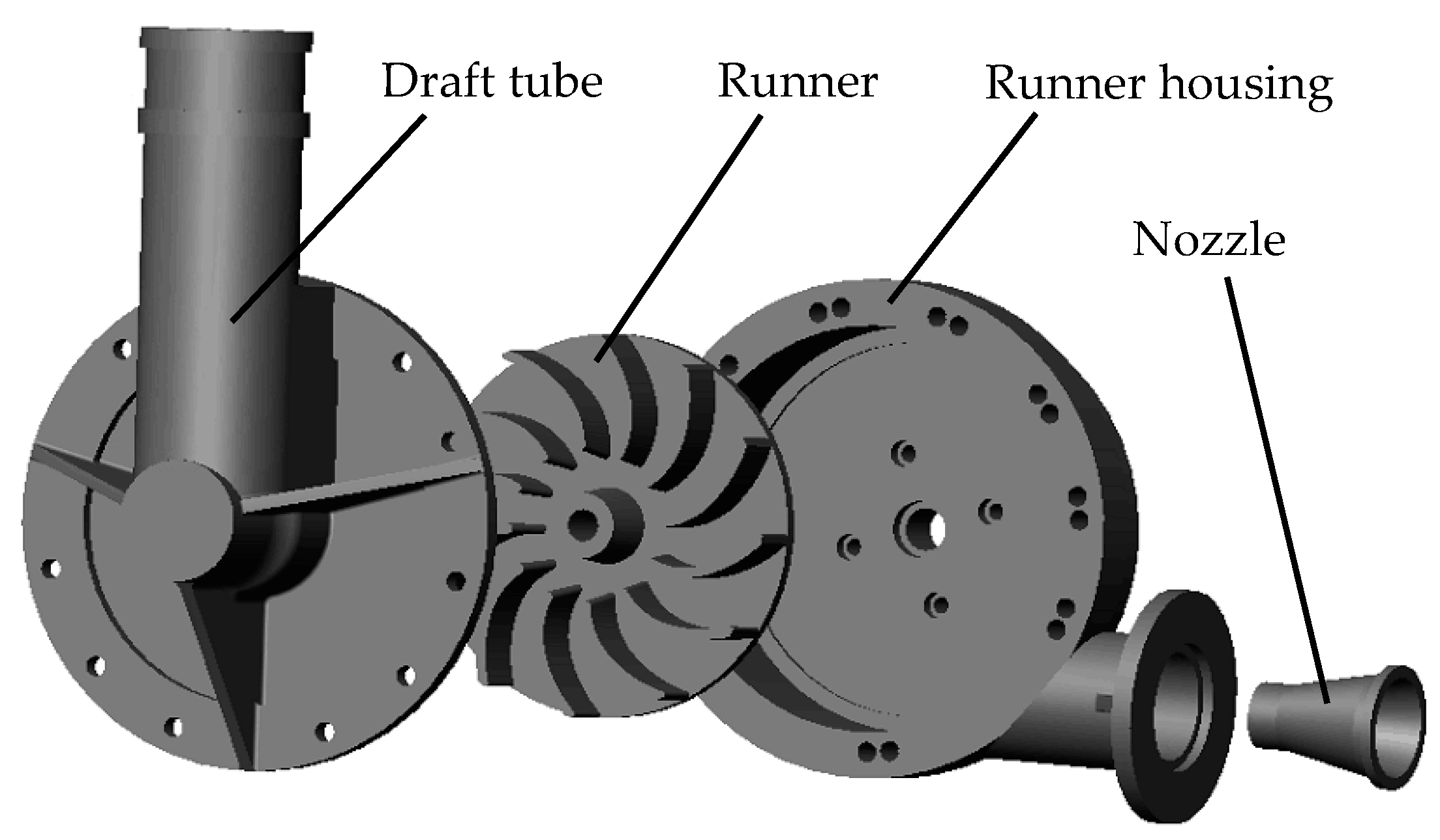


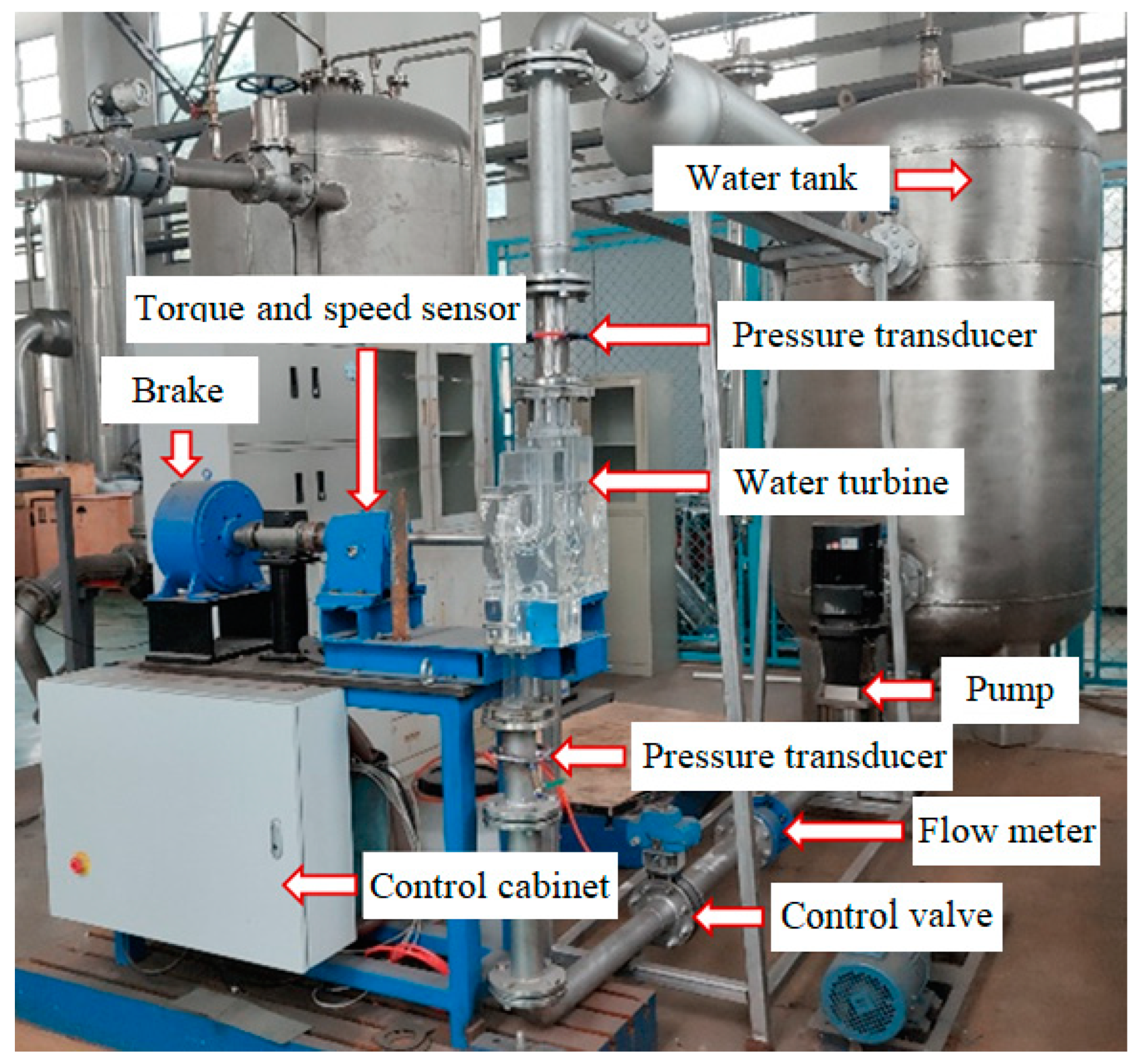
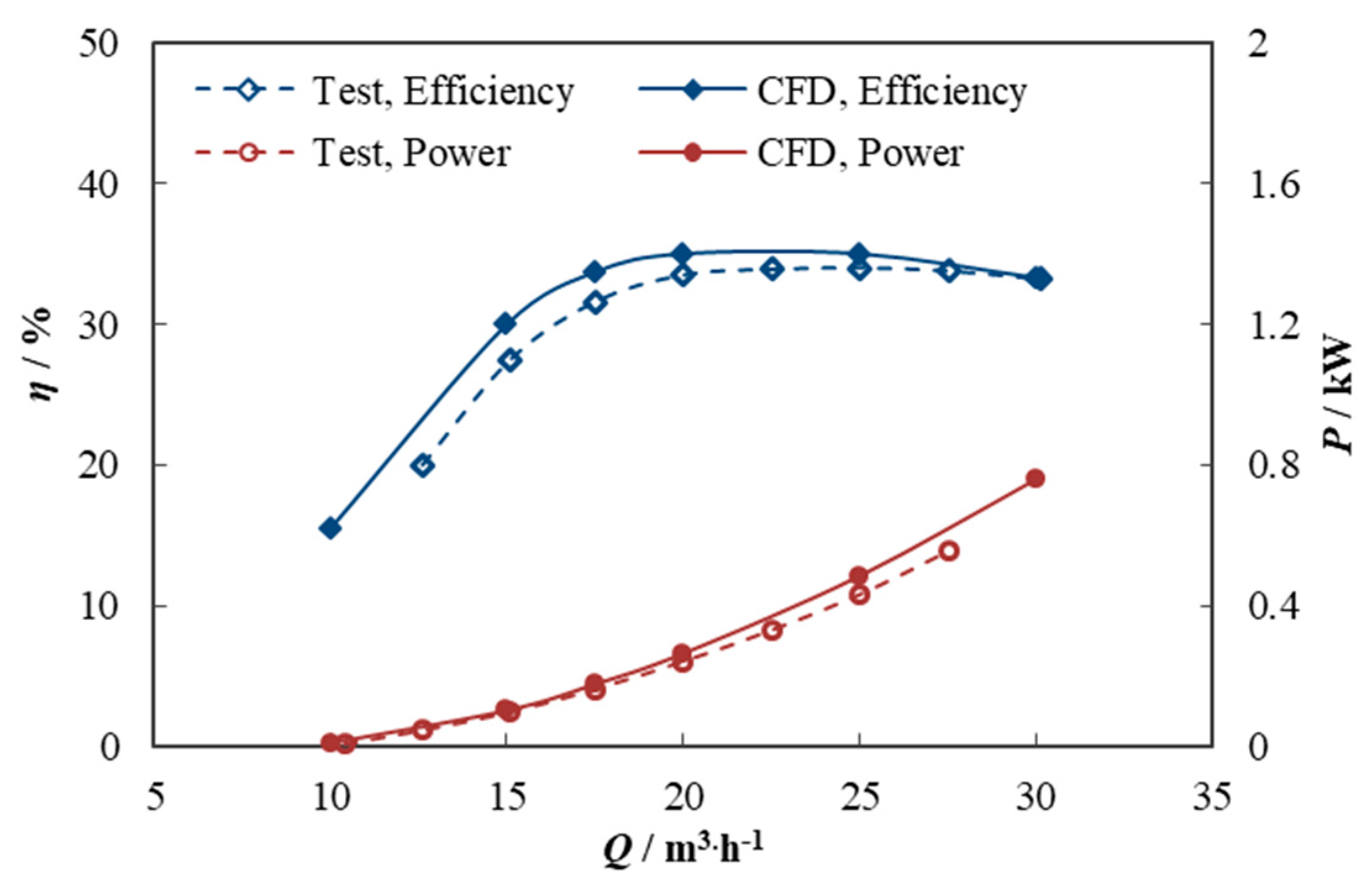
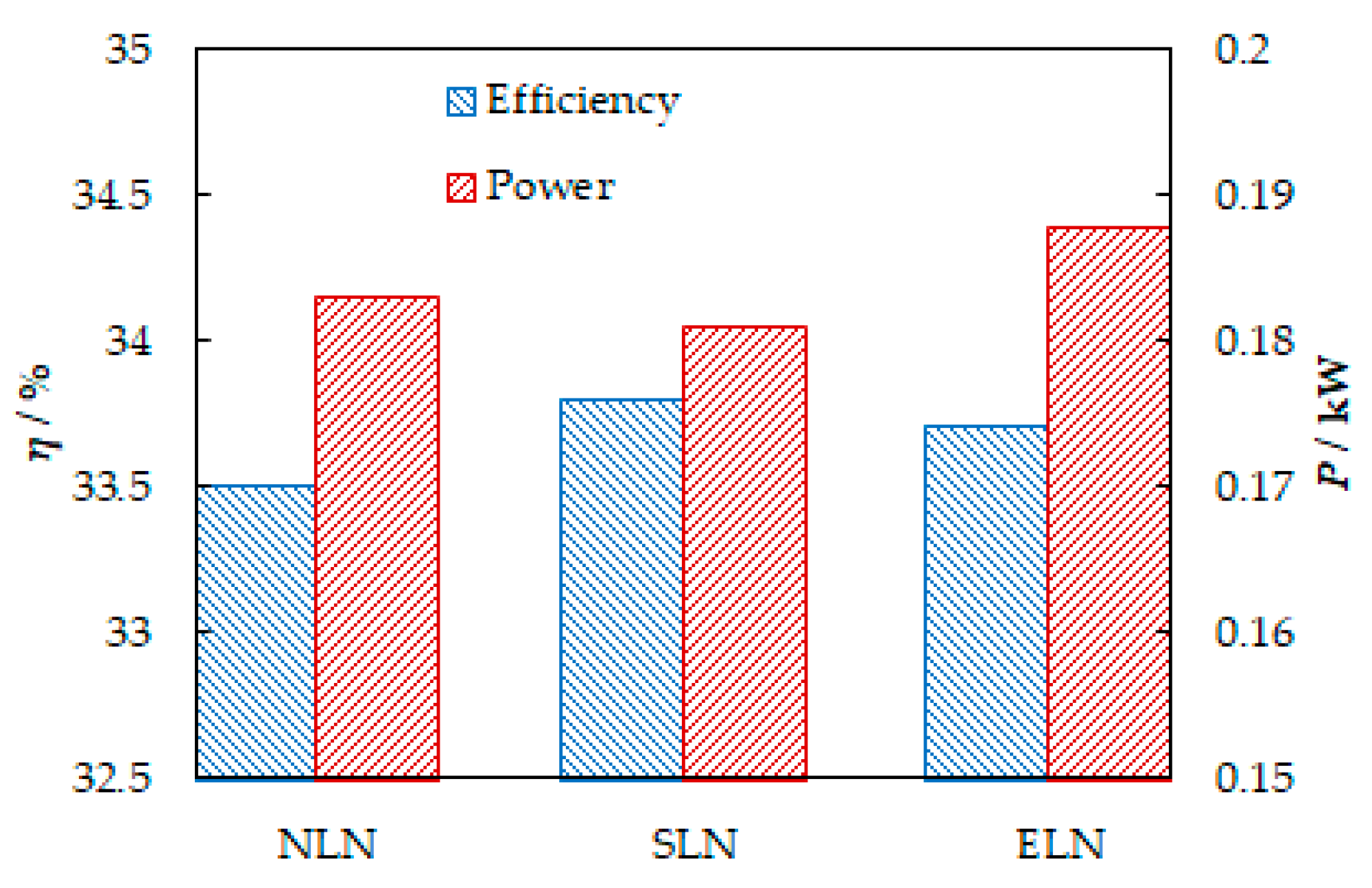

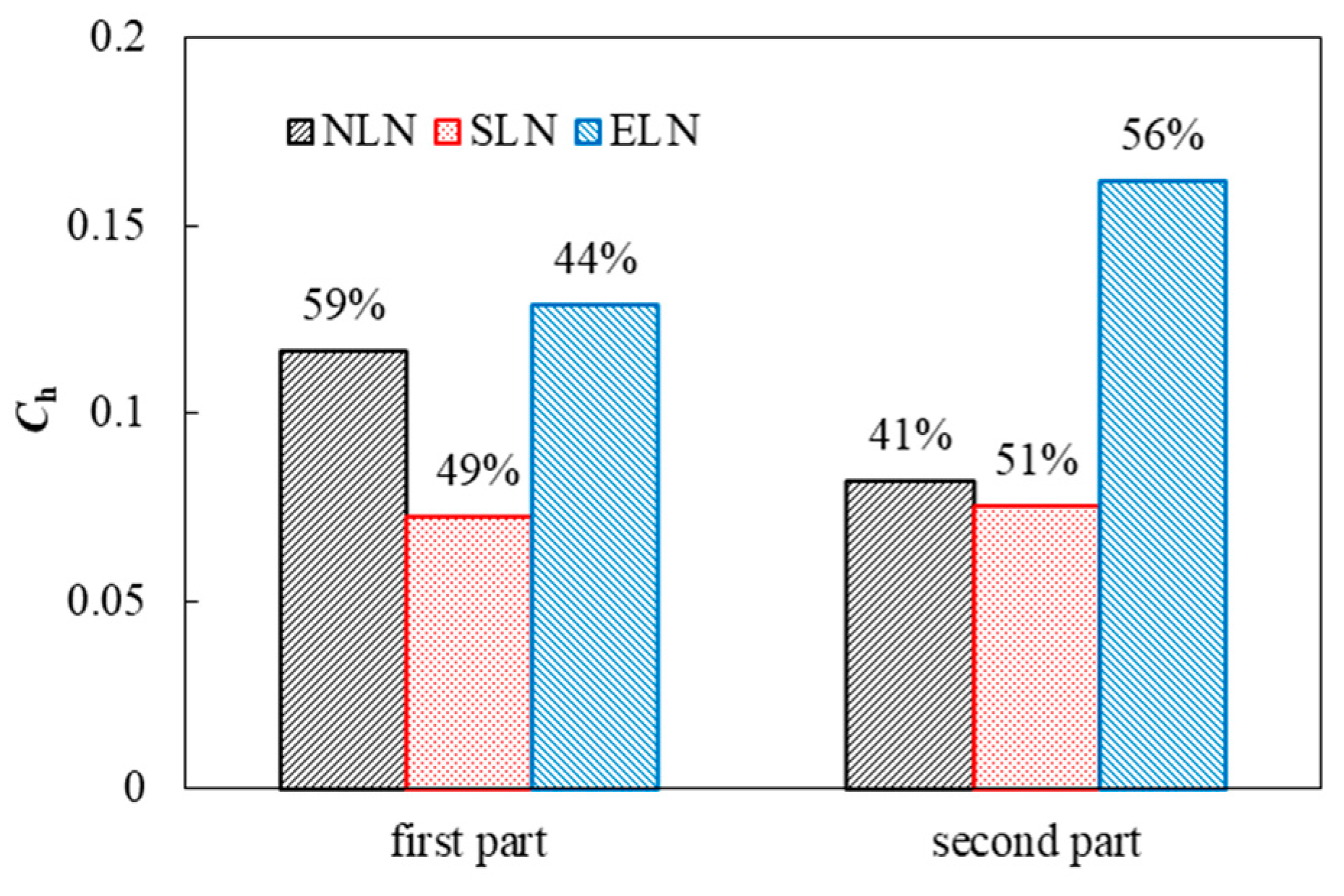
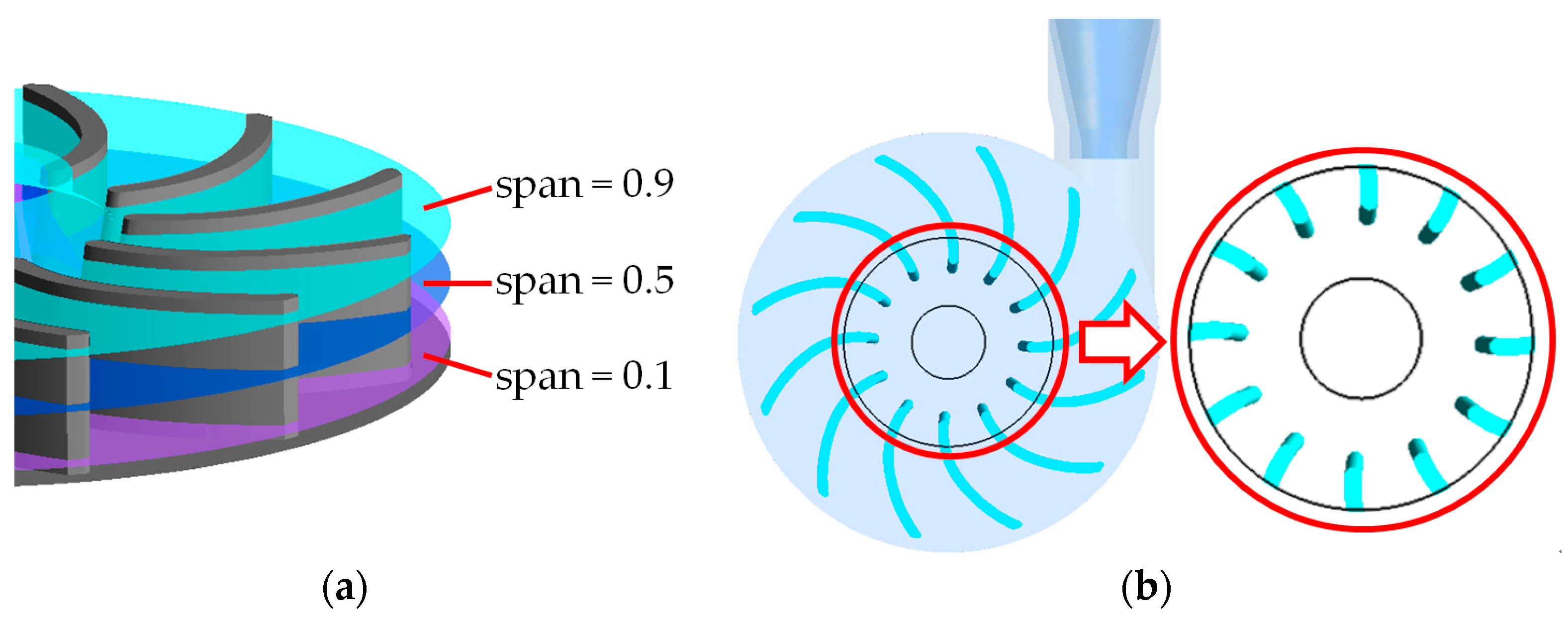



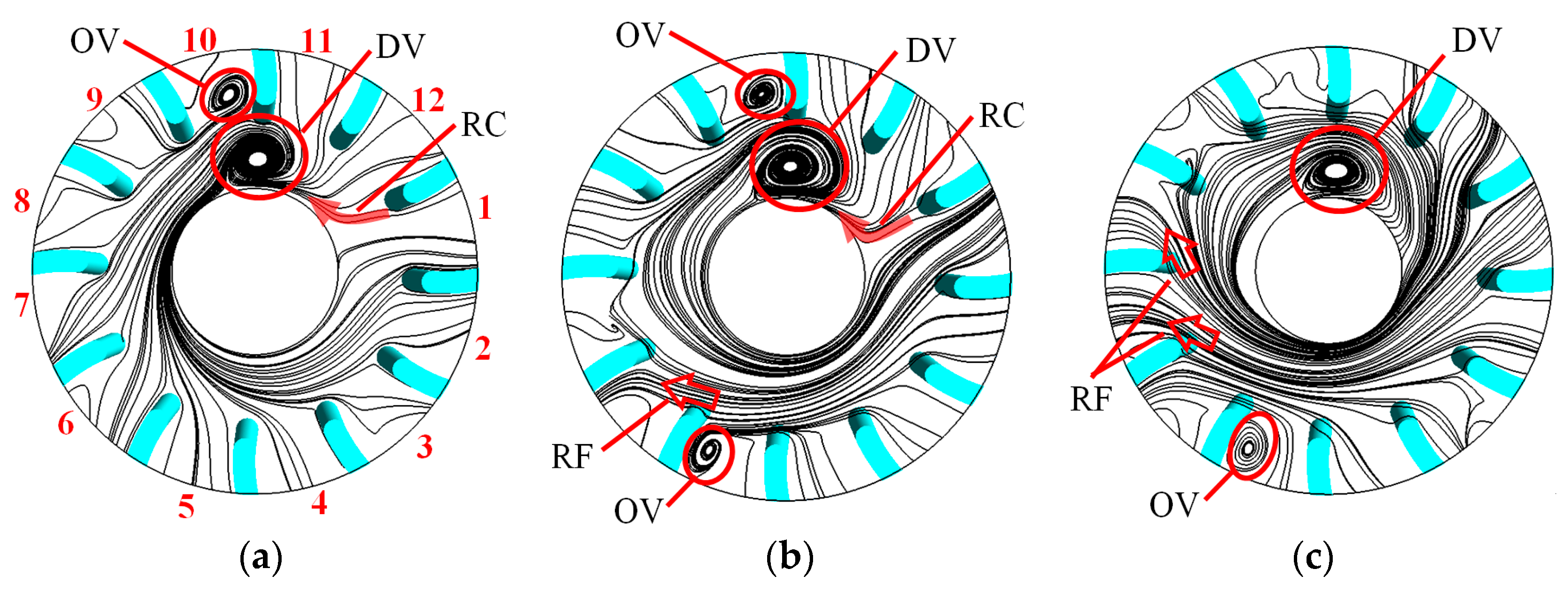
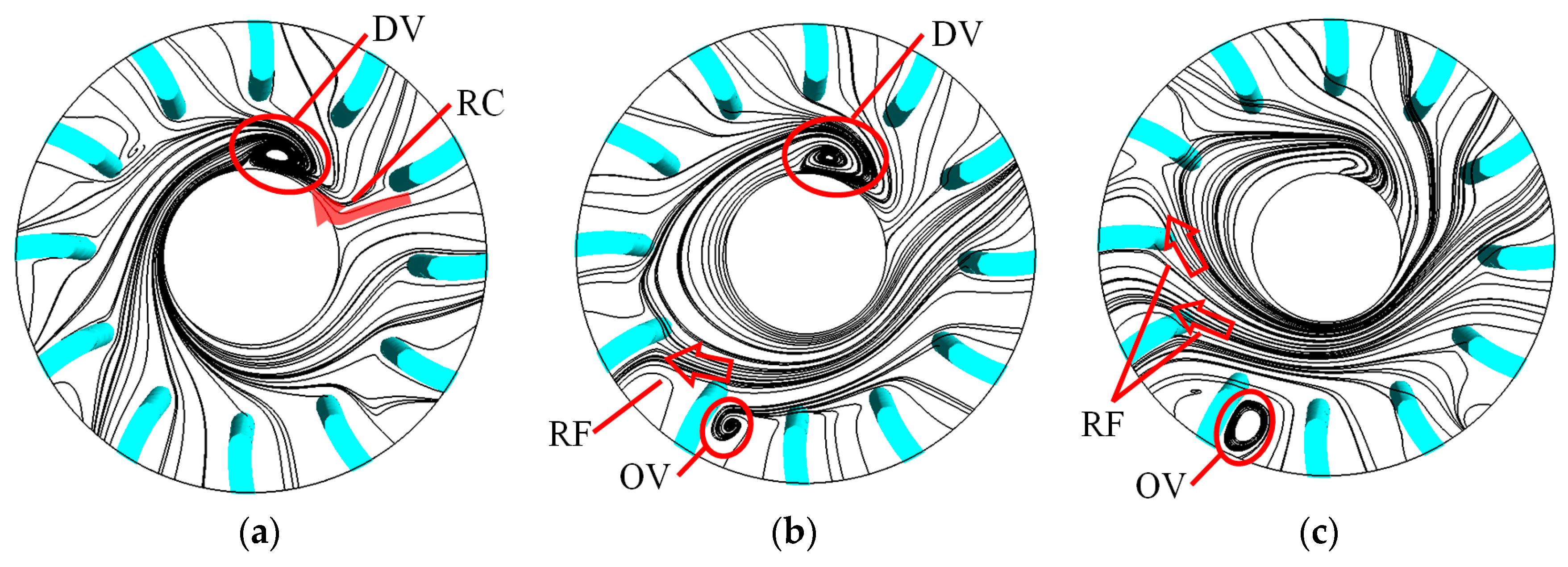
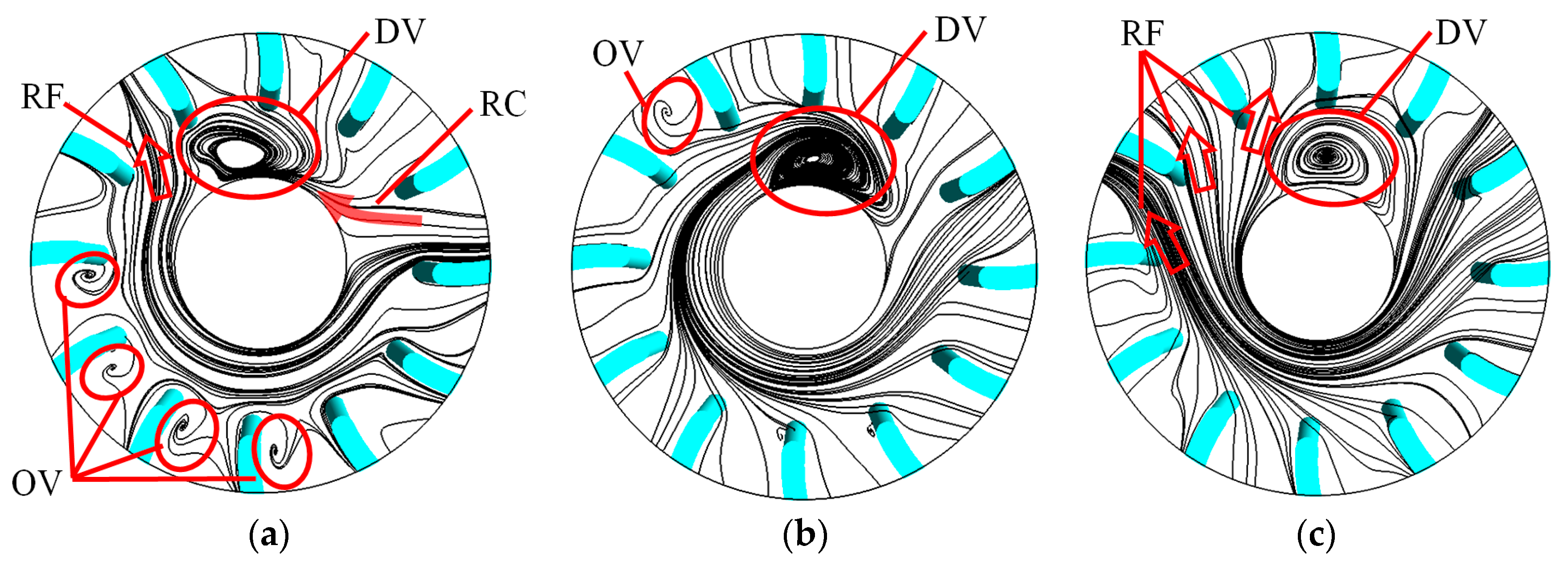




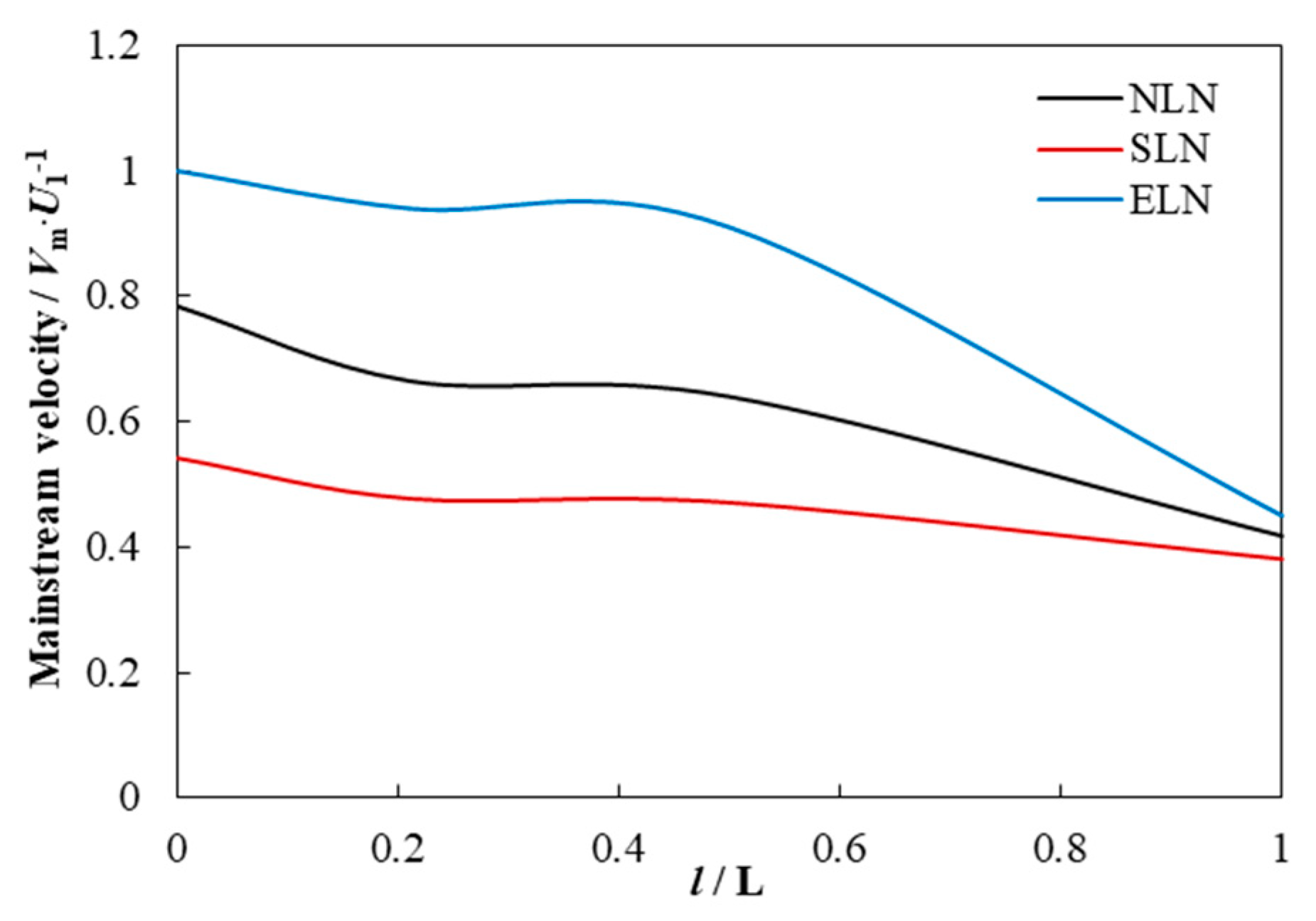
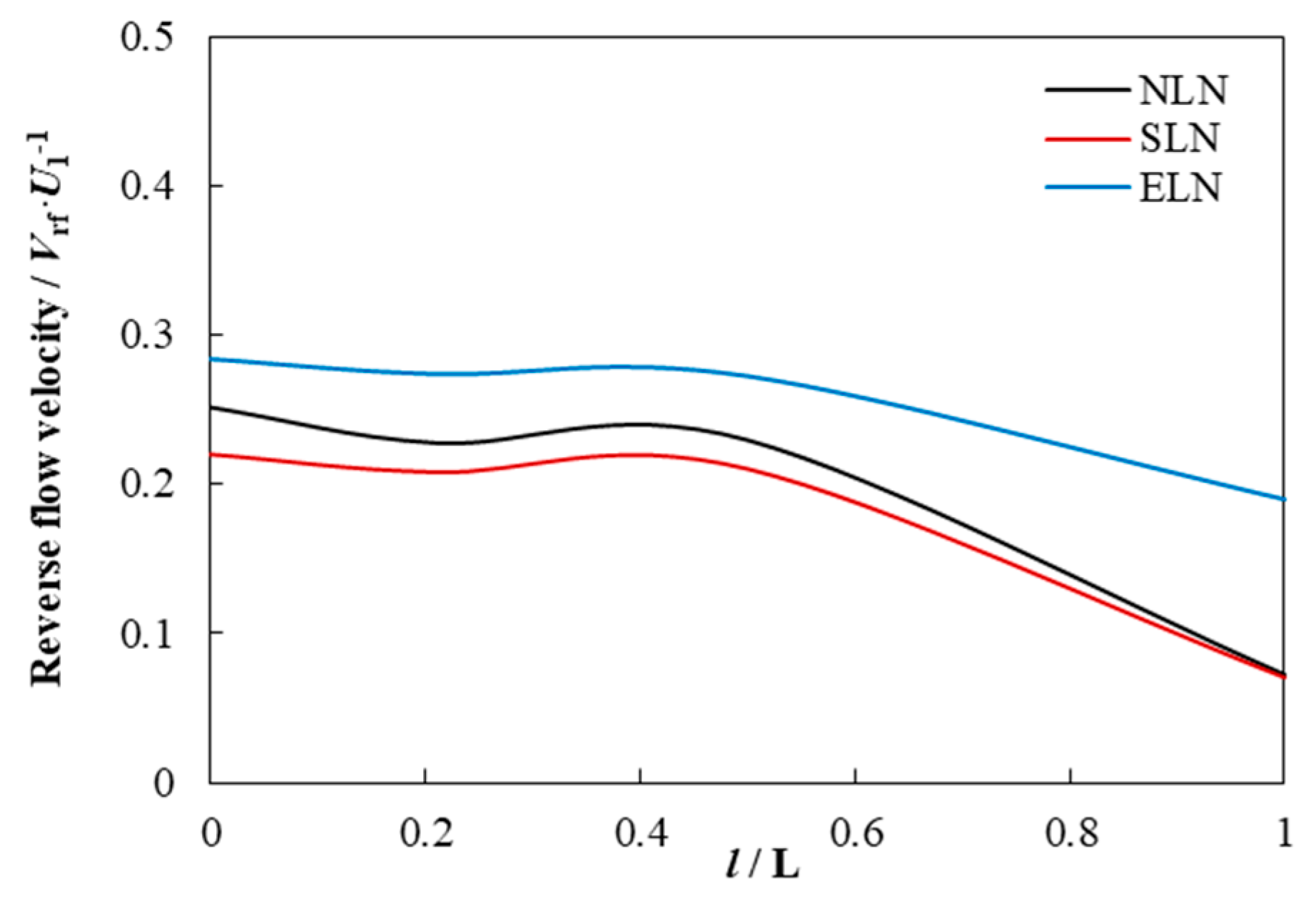
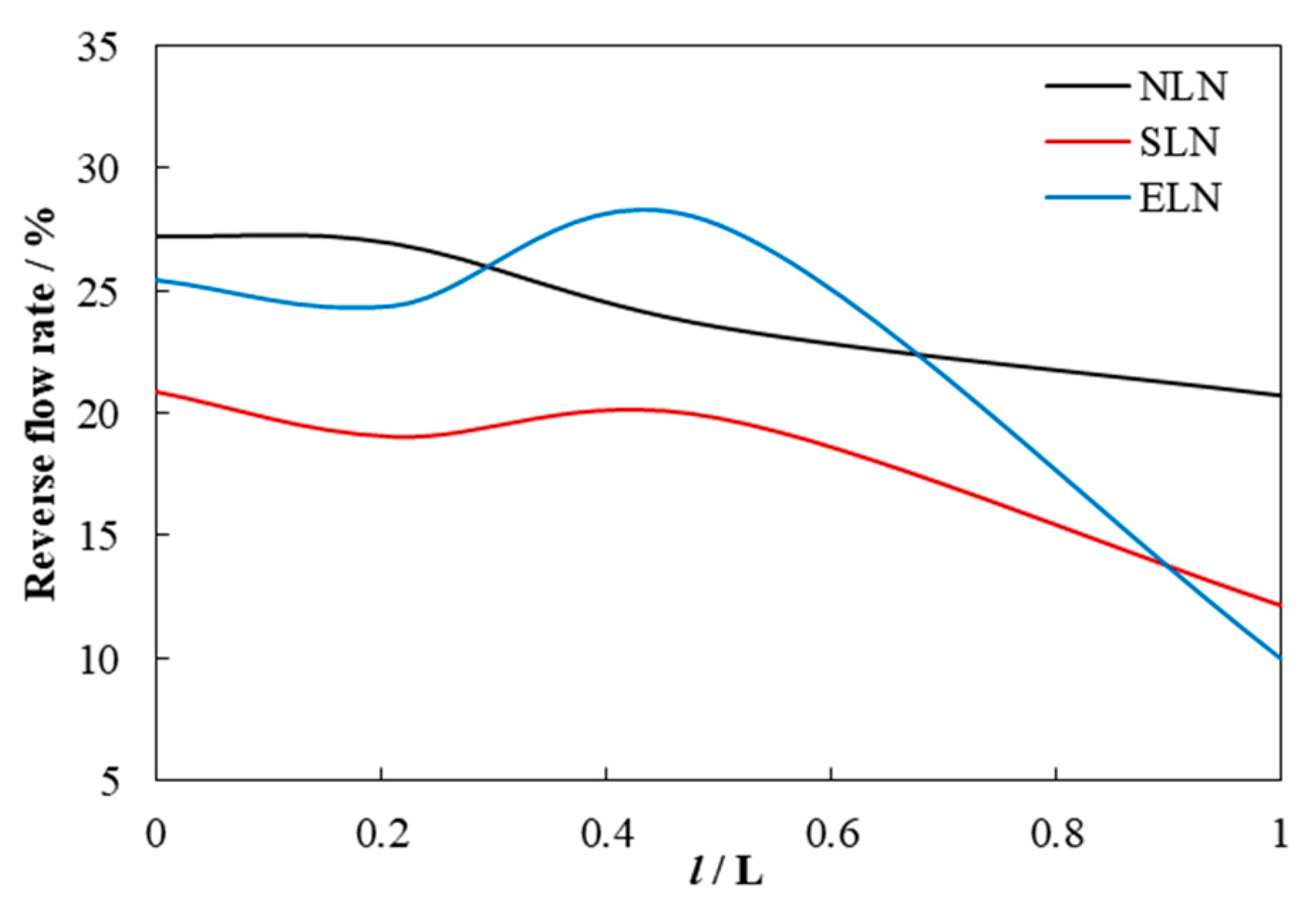




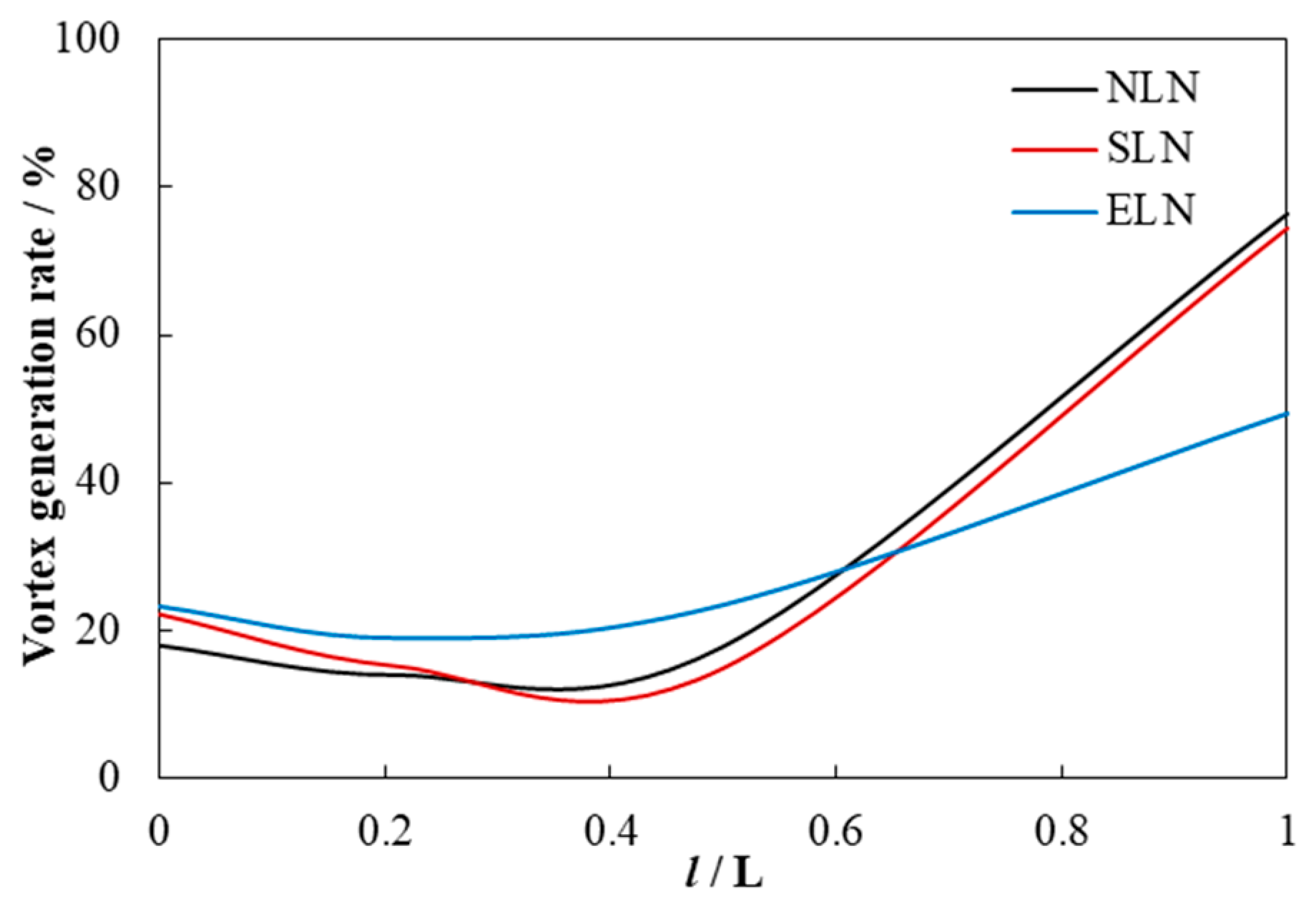
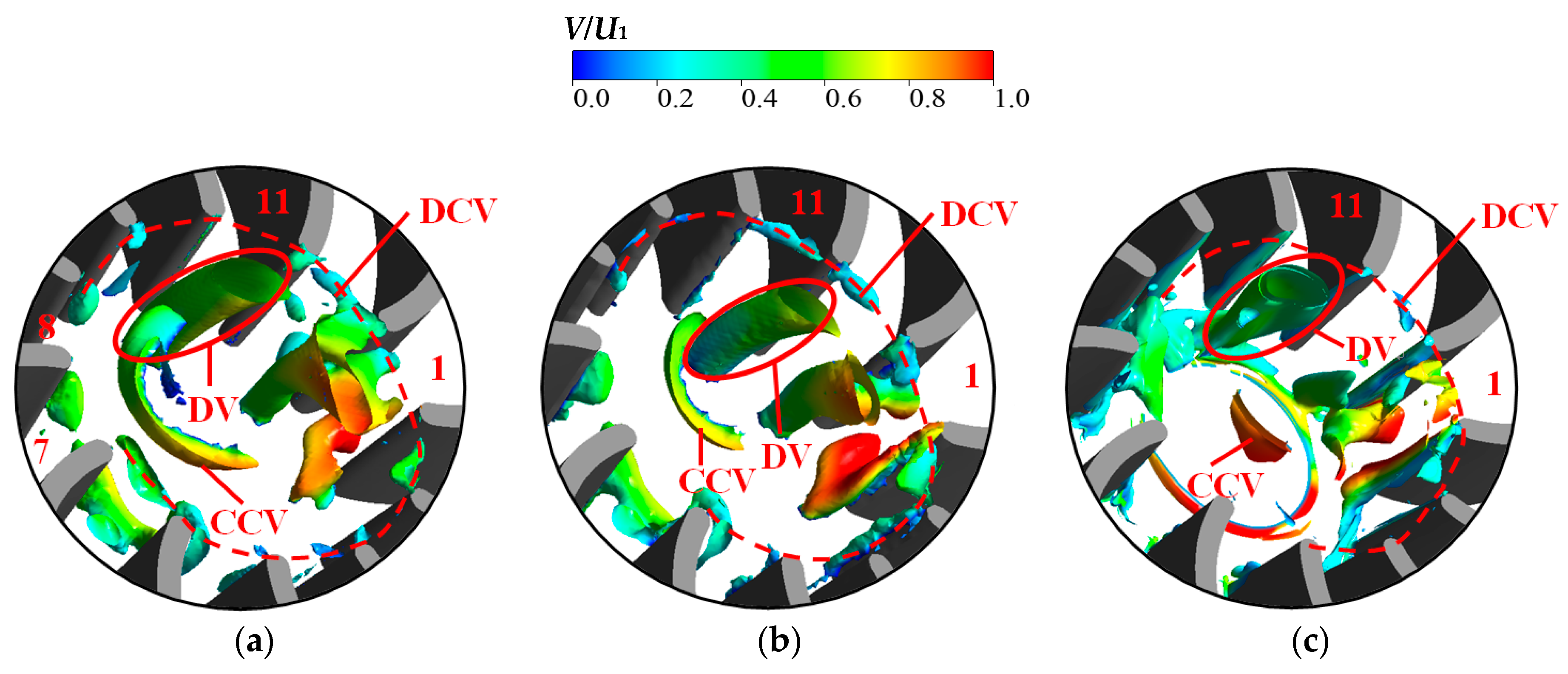



| Item | Parameter | Value |
|---|---|---|
| Operation | Flow rate, Q/m3·h−1 | 17.5 |
| Rotational speed, N/r·min−1 | 700 | |
| Head, H/m | 11 | |
| Geometry | Draft tube diameter, d/mm | 60.18 |
| Runner inlet diameter, D1/mm | 88 | |
| Runner outlet diameter, D2/mm | 190 | |
| Blade number, Z | 12 | |
| Inclination angle of blade outlet, γ2/° | 80 |
| No. 1 | No. 2 | No. 3 | No. 4 | No. 5 | No. 6 | |
|---|---|---|---|---|---|---|
| Number of grids N/×106 | 0.9 | 2.1 | 3.2 | 4.6 | 6.6 | 8.3 |
| Efficiency η/% | 31.2 | 32.3 | 33.6 | 33.8 | 34.0 | 34.1 |
| Relative error ε/% | / | 3.53 | 4.02 | 0.59 | 0.59 | 0.29 |
| No. | Instrument | Type | Specification | Quantity |
|---|---|---|---|---|
| 1 | Torque and speed sensor | JN338-A | 20 N·m, 0.2% F·S | 1 |
| 2 | Pressure transducer | CYG1103 | 160 kPa, 0.25% | 2 |
| 3 | Brake | TL-POD-20 | 20 N·m, 1500 rpm | 1 |
| 4 | Flow meter | MBmag | DN50, 0.5% | 1 |
Disclaimer/Publisher’s Note: The statements, opinions and data contained in all publications are solely those of the individual author(s) and contributor(s) and not of MDPI and/or the editor(s). MDPI and/or the editor(s) disclaim responsibility for any injury to people or property resulting from any ideas, methods, instructions or products referred to in the content. |
© 2024 by the authors. Licensee MDPI, Basel, Switzerland. This article is an open access article distributed under the terms and conditions of the Creative Commons Attribution (CC BY) license (https://creativecommons.org/licenses/by/4.0/).
Share and Cite
Tang, L.; Wang, W.; Zhang, C.; Wang, Z.; Yuan, S. Influence of Runner Downstream Structure on the Flow Field in the Runner of Small-Sized Water Turbine. Machines 2024, 12, 392. https://doi.org/10.3390/machines12060392
Tang L, Wang W, Zhang C, Wang Z, Yuan S. Influence of Runner Downstream Structure on the Flow Field in the Runner of Small-Sized Water Turbine. Machines. 2024; 12(6):392. https://doi.org/10.3390/machines12060392
Chicago/Turabian StyleTang, Lingdi, Wei Wang, Chenjun Zhang, Zanya Wang, and Shouqi Yuan. 2024. "Influence of Runner Downstream Structure on the Flow Field in the Runner of Small-Sized Water Turbine" Machines 12, no. 6: 392. https://doi.org/10.3390/machines12060392
APA StyleTang, L., Wang, W., Zhang, C., Wang, Z., & Yuan, S. (2024). Influence of Runner Downstream Structure on the Flow Field in the Runner of Small-Sized Water Turbine. Machines, 12(6), 392. https://doi.org/10.3390/machines12060392





